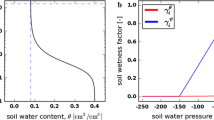Abstract
The significance of soil water redistribution facilitated by roots (an extension of "hydraulic lift", here termed hydraulic redistribution) was assessed for a stand of Artemisia tridentata using measurements and a simulation model. The model incorporated water movement within the soil via unsaturated flow and hydraulic redistribution and soil water loss from transpiration. The model used Buckingham-Darcy's law for unsaturated flow while hydraulic redistribution was developed as a function of the distribution of active roots, root conductance for water, and relative soil–root (rhizosphere) conductance for water. Simulations were conducted to compare model predictions with time courses of soil water potential at several depths, and to evaluate the importance of root distribution, soil hydraulic conductance and root xylem conductance on transpiration rates and the dynamics of soil water. The model was able to effectively predict soil water potential during a summer drying cycle, and the rapid redistribution of water down to 1.5 m into the soil column after rainfall events. Results of simulations indicated that hydraulic redistribution could increase whole canopy transpiration over a 100-day drying cycle. While the increase was only 3.5% over the entire 100-day period, hydraulic redistribution increased transpiration up to 20.5% for some days. The presence of high soil water content within the lower rooting zone appears to be necessary for sizeable increases in transpiration due to hydraulic redistribution. Simulation results also indicated that root distributions with roots concentrated in shallow soil layers experienced the greatest increase in transpiration due to hydraulic redistribution. This redistribution had much less effect on transpiration with more uniform root distributions, higher soil hydraulic conductivity and lower root conductivity. Simulation results indicated that redistribution of water by roots can be an important component in soil water dynamics, and the model presented here provides a useful approach to incorporating hydraulic redistribution into larger models of soil processes.
Similar content being viewed by others
Author information
Authors and Affiliations
Additional information
Electronic Publication
Rights and permissions
About this article
Cite this article
Ryel, R., Caldwell, M., Yoder, C. et al. Hydraulic redistribution in a stand of Artemisia tridentata: evaluation of benefits to transpiration assessed with a simulation model. Oecologia 130, 173–184 (2002). https://doi.org/10.1007/s004420100794
Received:
Accepted:
Published:
Issue Date:
DOI: https://doi.org/10.1007/s004420100794




